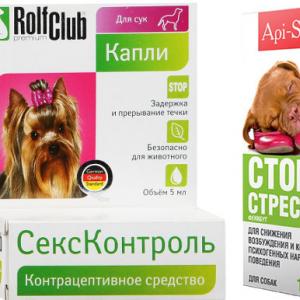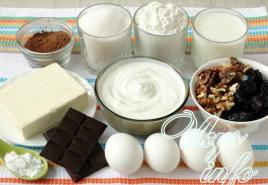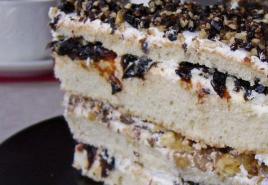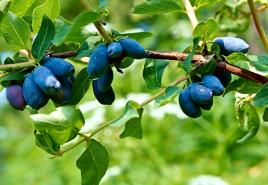Cachexia in dogs. Exhaustion in a dog: causes, what to do, treatment Exhausted dog
HOW TO FATTER A THIN DOG IN NATURAL? Introduce black tripe into your diet (unpeeled and do not trim the fat), choose higher-calorie types of protein and pieces of meat - lamb, beef cheeks, beef heart, udder, chicken and turkey necks, thigh cuts and turkey fillets. Increase the portion by 1/4 and introduce the 3rd feeding. Calculate the diet as follows: the entire daily volume of food is equal to 4-5% of the dog’s weight, of which 70% are products containing animal protein, 15% chopped vegetables, 10% cereals (rice & buckwheat), as well as steamed bran, flakes and 5% unsweetened fruits, greens, neraffin. oils and 3% quality raw animal fats. You should increase the caloric content of your diet, increase the proportion of high-quality protein and raw animal fats (from kidneys, tripe, heart and trimmings) - add it to cereals and bran, choose higher-calorie foods, red varieties of fish (salmon soup, pink salmon, haddock , cod, sea bass), increase the fat content of fermented milk products cottage cheese 5-9%, kefir 2.8%, give whey and fermented baked milk), sometimes you can give banana as a fruit, it is high in calories. Sometimes cook jellied meat without salt and spices, add 2-3 tablespoons to the meat. Add some cereals to the diet; for a short period of time, you can give pasta made from durum wheat (expensive, Italian). Old dog lovers from the St. Petersburg Kennel Club recommended this recipe for quickly setting up a show uniform: “steam coarse rolled oats, add vegetables, any meat - 2 times a week. And also durum wheat pasta with not very fatty cheese, egg - also 2 times/week. And all this, of course, with active walks and exercises, so that the muscle grows and not the fat! And here is the advice of veterinarian nutritionist Rumiya Feyzulova: HOW TO FATTER A DOG: We increase the fat content of the diet by giving enough fatty meat and meat products, and simply give more. For those who overcook, you can add a little pasta and cereals. We feed 1-2 times a day. It is an absolutely useless and harmful activity to fatten something that either has the same anatomy or is somewhat thin due to age. A healthy teenager rattles his bones, figuratively speaking. An attempt to make it bulky and fatty is fraught with the development of a negative attitude towards the feeding process, even a perverted perception of food, joint diseases and excessive stress on the digestive organs. Just let the teenager grow up! Give him the opportunity to move a lot, to form his skeleton, ligaments and muscle corset. A normal, healthy dog will develop excellent muscles on its own and gain the much-desired substance with age. Only this substance will be healthy muscle tissue, and not flabby fat." (c) In case of a lack of enzymes, it is recommended to give black, unpeeled and ungutted tripe (with silage grass) 2-3 times a week, as well as 1-2 times a week give cured meat for a week, which is called “with flavor” (beef only), for which the meat is left in a sealed jar in the sun for a couple of days. Also, products are added to the meat and necks to speed up fermentation - to choose from: kiwi puree, ripe. kefir, pieces of pineapple & papaya or a spoonful of homemade sauerkraut juice, without vinegar. And choose vegetables that speed up the metabolism and increase the acidity of the bile juice - zucchini, zucchini, cabbage, red bell pepper, grind all vegetables and fruits in a blender or on a grater. until it becomes a mush that sticks to finely chopped pieces of meat, so that the dog does not choose the meat, leaving the side dish (rice and buckwheat), you can soak it in the form of “friendship” in the evening and in the morning, cook it in water, covered, over low heat until crumbly, just like that. At the end, add grated vegetables, meat, cut into cubes and leave to brew for 20 minutes, turning off the heat. Before serving, add flaxseed oil and finely chopped herbs. Vegetables and cereals should have the consistency of “putty” and tightly adhere to each piece of meat. For better eatability, you can sometimes add a spoonful of low-fat sour cream, grated cheese or a drop of salmon oil (purified fish oil without additives). The diet should include greens, fresh leaves of young nettle (steamed), dandelion - its flowers and crushed steamed root contain bitterness that promotes appetite. As prescribed by the doctor, vitamins containing yeast and enzymes are given: Canina Enzyme Hefe, Canina Petvital Energy Gel and Volmar for gaining muscle mass, as well as a high-quality probiotic, for example lactobifadol or Florentine paste, for 14-21 days. Ground flax seed and milk thistle meal are added to the food in a course. If these measures do not help, you should consult a doctor and check the absence of worms and protozoa, the functioning of the pancreas and the sufficiency of enzymes. Very likely the dog simply does not have enough enzymes to digest and assimilate food. Take a stool test and see how meat and fiber are absorbed. Author I Vidus
There are significant differences between simple starvation of a healthy animal and cardiac cachexia. A healthy animal loses predominantly adipose tissue, while cachexia is accompanied by a loss of muscle mass.
There is a significant difference in the metabolic processes occurring in healthy fasted animals and animals with cachexia. Healthy animals use fat reserves, while with cachexia, structural proteins are included in catabolism.
Cardiac cachexia usually occurs after the development of congestive heart failure. However, it is more often observed in dogs with CHF (congestive heart failure), the cause of which is dilated cardiomyopathy, especially in right-sided CHF. One study found that over 50% of dogs with MVR (mitral valve disease) had some degree of cachexia. Exhaustion has an extremely adverse effect on the immune status of the body and the general condition of the animal, so it is very important to recognize cachexia in the early stages for timely intervention and effective control.
Loss of muscle mass in cardiac cachexia is caused by anorexia, increased energy demand and dysmetabolic processes. Anorexia is often secondary in response to dyspnea, apathy, drug intoxication, as well as food that lacks palatability. Anorexia is reported in 34-75% of dogs with heart disease. There are currently no data on the energy requirements of dogs with CHF, but it has been established that in humans with CHF the energy requirement increases by up to 30%.
In the development of cachexia, a significant role is played by inflammatory cytokines, including tumor necrosis factor and interleukin-1, the production of which is significantly increased. It is known that these cytokines cause the appearance of anorexia, increased energy requirements and the intensity of catabolism. Moreover, TNF and IL-1 are responsible for cardiomyocyte hypertrophy and fibrosis and also have a negative inotropic effect.

Nutritional therapy for dogs with cardiac cachexia is aimed primarily at providing optimal amounts of energy and protein, as well as regulating cytokine production. Anorexia is a risk for dogs with CHF for several reasons. First of all, it contributes to the progression of cachexia, but most importantly, refusal of food prompts dog owners to decide on euthanasia. Indeed, one study showed that when euthanizing dogs with CHF, anorexia was a deciding factor in the decision for owners. Anorexia is more often observed in dogs with severe CHF and DCM, in contrast to dogs with chronic valvular disease (CVD).
Anorexia is often an early symptom of deterioration in dogs with HF, so it is important to:
- 1. Warming the feed to room temperature.
- 2. It is necessary to determine the toxicity of digoxin and intolerance to other medications, timely assess the patient’s status and take the necessary measures to control HF.
- 3. Increasing the frequency of feeding.
- 4. Switching to diets with high taste qualities.
One of the most important approaches to controlling anorexia is proper veterinary control of CHF. The earliest symptom of deterioration in dogs with CHF is decreased appetite. Another possible cause is drug side effects due to high digoxin toxicity, ACE inhibitor-induced azotemia or diuretic overdose. Food palatability may be a key factor in the management of anorexia and cachexia in general in dogs with CHF.
Diet intake can be increased by feeding small portions at short intervals and by warming the feed to room temperature. For other dogs, a gradual transition to more palatable food may be an effective solution. In order to increase the palatability of diets, the use of natural flavor enhancers is recommended.
In the fight against cardiac cachexia, a special role is given to means of controlling the synthesis of cytokines. Because specific anti-TNF agents have not been shown to be effective in people with CHF, the use of certain dietary supplements is considered a safer option. One such method to reduce the production and influence of cytokines is the use of Omega-3 polyunsaturated fatty acids. Fish oil, which serves as the main source of Omega-3 fatty acids, reduces the intensity of cytokine production in dogs with CHF and can achieve positive dynamics in the fight against cachexia. Decreased IL-1 production determines survival in dogs with CHF.
Optimal medical treatment and nutritional therapy can help reverse the process of cachexia and improve nutritional status. An objective assessment of the patient's nutritional status is difficult, however, there is one assessment parameter - this is the measurement of the concentration of insulin-like growth factor-1. The concentration of IGF-1 is taken into account when assessing nutritional status in humans and dogs. Low concentrations of IGF-1 have been found to positively correlate with survival rates, suggesting that maintaining good nutritional status in dogs can prolong their longevity. In people with CHF, cachexia is a poor prognostic symptom.
Excessive thinness of a dog can indicate a number of diseases, but this is not always the case. Pets adopted from shelters or from the street may be underweight due to a lack of protein, vitamins or microelements. Weight gain, as well as weight loss, should always be approached with caution, the main goal is not to cause harm by “disrupting” the animal’s metabolism. Let's consider what to feed your dog so that it gains weight and what measures need to be taken.
Naturally, the best option is to show the dog to a doctor and undergo a full examination. Firstly, a visit to the clinic is not always possible, and secondly, a comprehensive examination requires significant financial costs. To begin with, let’s exclude possible options “on the surface” that are logical:
Important! Diarrhea and vomiting lead to rapid... If you are confident that you have the situation under control and are not going to see a veterinarian, add rehydron to your dog’s drink to avoid rapid loss of muscle mass.
Cachexia or wasting in a dog occurs as a result of slow or rapid weight loss for various reasons.
Exhaustion can be recognized by certain signs, in particular by clearly visible ribs, a strongly retracted abdomen, in addition, an exhausted dog exhibits lethargy and loss of strength. Exhaustion also affects the shine of the coat; the animal may refuse to feed.
However, visible ribs and a retracted abdomen may not necessarily be signs of emaciation. Some dog breeds are genetically predisposed to thinness, such as greyhounds.
Causes of wasting in dogs
As a rule, dogs with such diseases lose their appetite or eat too little, and as a result they lose weight. An animal may refuse food when under stress.
Pregnancy and lactation. During pregnancy and after childbirth, the bitch may experience hormonal imbalances. As a result, the bitch can suddenly lose weight. If the dog does not gain weight for a long time with proper feeding, then tests should be taken.
Lack of feed. One of the common reasons is insufficient feeding and improper maintenance of the animal. Dogs that were once pets, but then for some reason ended up on the street, especially suffer from hunger. As a rule, it is difficult for them to obtain food for themselves, because they are accustomed to the fact that food was always provided by the owner. Some unscrupulous owners deliberately starve their animals. In most cases, thinness in puppies with proper feeding is the result of a lack of food. You may need to increase your puppy's food intake.
Increased physical activity. Active, working or sporting dogs may lose weight if not fed enough, which is usually immediately noticeable.
Diagnosis and treatment
An accurate diagnosis can only be made by contacting a veterinarian. After all, if there are signs of exhaustion in a dog, this does not always mean that the pet needs to be treated by fattening it. In most cases, the cause of exhaustion in dogs is various types of diseases. Then you need to first eliminate the cause of exhaustion, and only then treat your pet for painful thinness.
If your pet is eating well, eating with pleasure, or even began to eat more food, then the cause of exhaustion may lie in problems digesting food. Perhaps the food is poorly digested and poorly absorbed. The cause may be enteritis.
If your pet has a decrease in appetite, then this is the reason for weight loss. It is necessary to find out why the dog has lost its appetite; such a phenomenon can be a symptom of various diseases, which only a veterinarian can determine.

Even if the cause of exhaustion is forced starvation, the dog should definitely be shown to a veterinarian, because under conditions of improper maintenance and feeding, serious diseases could develop.
You can fatten your dog yourself, but in some, especially serious cases, you cannot do without the help of a veterinarian. If the case is complex and the dog is severely exhausted, then it will need special nutritional supplements to maintain its vital functions. In addition, the veterinarian will advise the most suitable food depending on the nature of the existing diseases.
In the early stages of exhaustion, self-feeding is possible. Pet stores sell special medicinal or dietary wet food. It is important to remember that an exhausted dog cannot be fed dry food right away. If you have any doubts about your pet's recovery process, it is best to consult a veterinarian.
How and what to feed an exhausted dog
To restore the weight of emaciated animals, use only wet food, preferably natural food. The food, consisting of beef or chicken, boiled rice, and boiled vegetables, should have a consistency similar to liquid porridge. There must be at least 50% meat. Food should not be greasy or heavy. Fermented milk products (low-fat cottage cheese and kefir) are introduced gradually, separately from the main food for timely detection of allergic reactions.
Treatment with dry food is contraindicated. Medicinal or dietary dry food can be given only after the animal has fully recovered, gradually replacing natural products. Later, the pet is gradually transferred to complete dry food, since medicated food is not intended for constant feeding. The dog should always have water during the recovery period and after.
Feeding should begin with two meals a day, gradually increasing the volume of food and the frequency of feeding. With noticeable improvements in the pet's condition, they begin to feed 4-5 times a day, but in small portions, i.e., the daily portion intended for a healthy dog is divided into 4-5 parts and fed throughout the day. It is important not to overfeed an exhausted dog, especially if the exhaustion is severe.
The first signs of improvement in the pet's condition are manifested in activity, weight gain, and shiny coat. After the condition improves, deworming is carried out. Improvements are observed within the first month, but full recovery takes longer, and until this point the dog must eat a strict diet.
Sometimes a dog loses a lot of weight after a long illness or due to other reasons. What to feed your dog so that it gains weight - this issue needs to be dealt with in a timely manner. Remember that you need to fatten the animal in such a way as not to disrupt the metabolism in the body.
Before you decide how to properly feed a thin dog so that it gets fat, you need to figure out whether the weight really cannot be called sufficient for its physique and age. Both his health and his predisposition to illnesses in later life depend on whether the pet’s weight is normal. At a normal weight, the dog develops fully, and intense physical activity does not burden it.
Video “How and what to feed a dog”
In this video, experts will tell you how to feed your dog properly.
Causes of weight loss
Sometimes the owner of a four-legged creature notices that his pet suddenly began to rapidly lose weight and eat poorly. The best way out of the situation is to show the dog to a veterinarian and undergo a comprehensive comprehensive examination. However, keep in mind the fact that this will cost you a decent amount. That’s why you should first establish the reason for your dog’s rapid weight loss, and only then make a decision.
Common factors that cause weight loss in a pet include the following:
- Feeding your pet's offspring. After this, the dog usually requires serious recovery.
- Dogs living in the same house cannot share food among themselves. In this case, it is advisable to isolate the malnourished dog from other individuals during feeding.
- The dog suffered from a helminth infestation. In this case, you need to give the animal special anti-worm medications, otherwise the consequences may be tragic.
- This is due to the young age and individual characteristics of the breed.
Feeding offspring
Lack of appetite is not always associated with health problems in your pet. Sometimes she does not feed very actively and at the same time loses weight due to the fact that most of the nutritional components are lost along with the milk. When a dog fattens its offspring, it often loses weight. In this case, it is recommended to increase the portions.
Also make sure that your daily menu includes vitamins. Then the puppies will receive more useful substances along with their mother’s milk, and the tailed mother herself will not actively lose weight. We should not forget that sometimes the birth of babies in dogs is associated with serious complications. The reason for this is surgery or illness.
High competition for food
Sometimes the owner of four-legged creatures does not notice the exhaustion of one of the pets in a timely manner. It would seem that the food is distributed evenly, and each of your doggies has their own bowl for food. However, keep an eye on your animals while feeding: it is quite possible that someone is left without treats because they cannot win their “place in the sun.” All you have to do is feed the deprived dog in another room so that his food is not taken away.
Age and characteristics of the breed
Among the reasons for a dog's sudden weight loss, it is also worth highlighting its age and individual characteristics. For example, representatives of working dog breeds often gain weight by the age of 2-3 years. This is explained by the fact that the animal’s metabolism is too active at an early age. Therefore, it is not worth increasing the daily diet.
Keep an eye on your dog first: if he continues to lose weight, you should show him to a specialist and check if everything is in order with his health. After consultation with your veterinarian, you can modify your daily diet.
How to fatten your pet
In order for your dog to look healthy, have a normal weight and stop shedding, it is necessary to provide it with a balanced diet. You can fatten her up using a set of the following products:
- high energy feeds. These include foods high in protein and protein;
- natural ingredients. Buckwheat, rice, oatmeal - such porridges contribute to weight gain. As for meat, it is better to give preference to beef, rabbit, chicken;
- unrefined vegetable oil - just add a few drops to the food;
- fish, liver, cottage cheese - these products are high in calories and can well diversify a dog’s daily diet.
It is not advisable to mix ready-made food with homemade products, since this will only disrupt the metabolism in your pet’s body.
What not to do
Some dog owners prefer to feed their four-legged friend semolina porridge prepared with milk. Refuse this dish, since the dog tolerates the processed wheat product, like cereals in general, with great difficulty. You should not feed your dog lamb and pork, as such meat is too fatty for him.
Do not replace meat with offal - they are given to the animal rarely, as a good meat supplement, but not as the main ingredient. The best option is porridge and soups with meat and vegetables. It is possible to prevent anorexia in your dog and increase his appetite if you follow the basic recommendations of your veterinarian.







